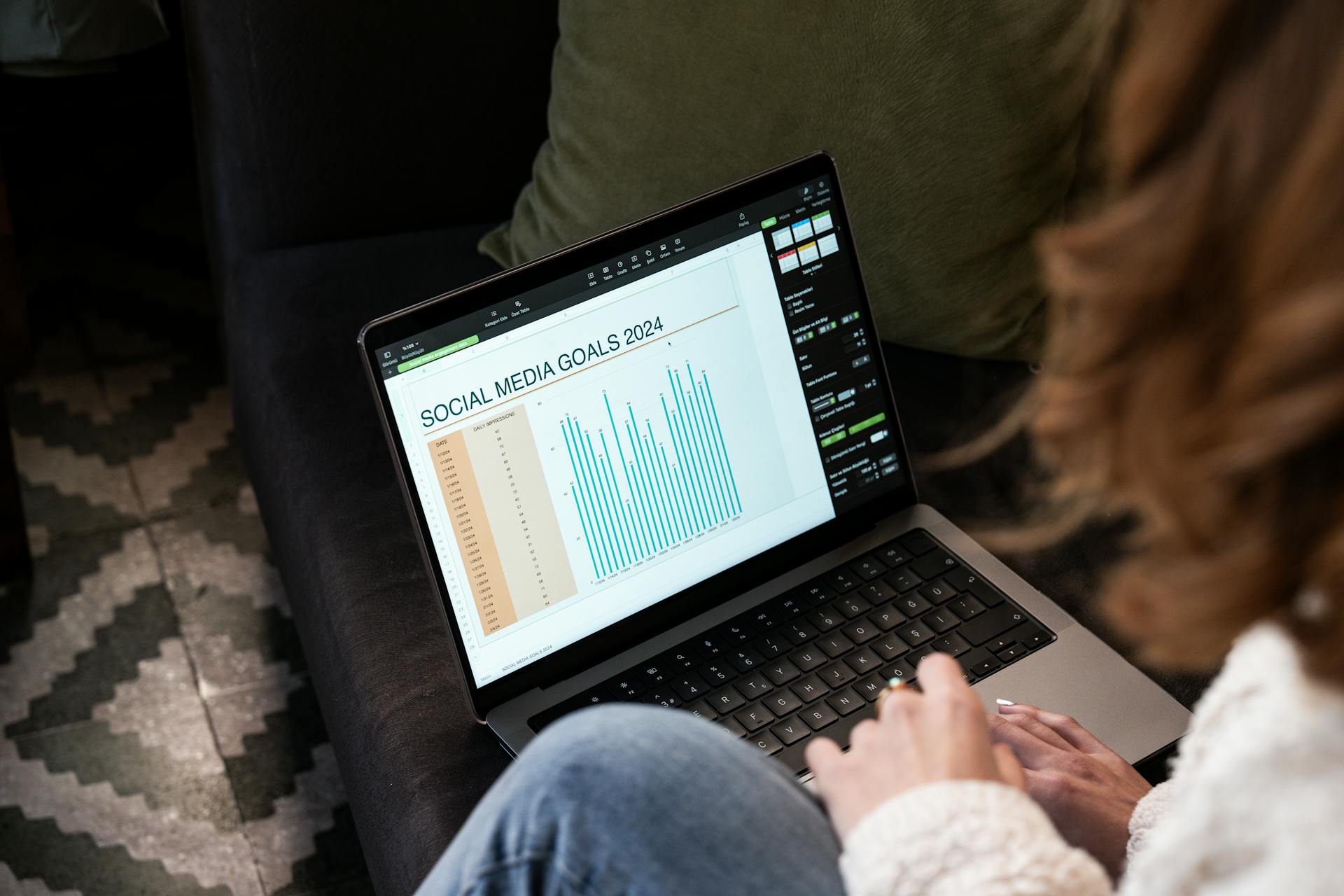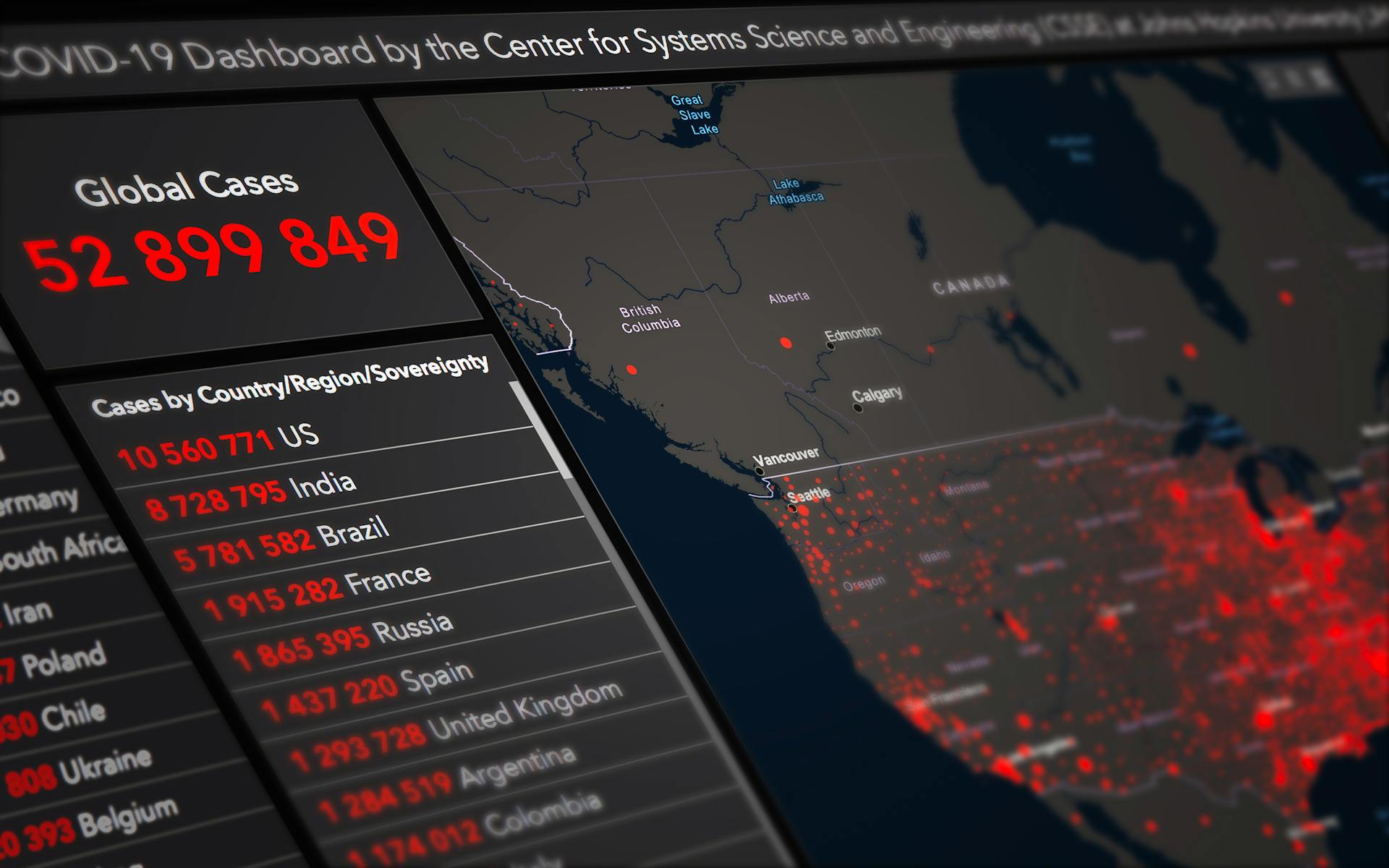
To create a contingency table, start by identifying the categorical variables you want to analyze. This could be anything from the color of a shirt to the type of music people listen to.
A contingency table typically consists of two variables, so choose one variable for the rows and another for the columns. For example, if you're analyzing the relationship between favorite food and favorite sport, "favorite food" would be the rows and "favorite sport" would be the columns.
Next, determine the categories for each variable. This could be as simple as "yes" or "no" or as complex as different types of music genres. In the example of favorite food and favorite sport, the categories for "favorite food" might be "pizza", "burgers", and "salad", while the categories for "favorite sport" might be "basketball", "soccer", and "tennis."
Take a look at this: In a Contingency Table the Number of Rows and Columns
Understanding Contingency Tables
Contingency tables are fundamental tools for summarizing and analyzing the relationship between categorical variables. They're like a map that helps you understand the connections between different groups.
A contingency table typically has multiple columns, with each row referring to a specific subgroup in the population. The columns are sometimes called banner points or cuts, and the rows are sometimes referred to as stubs.
Here are the standard contents of a contingency table:
- Multiple columns (historically, they were designed to use up all the white space of a printed page)
- Significance tests, such as column comparisons or cell comparisons
- Nets or netts, which are sub-totals
- One or more of: percentages, row percentages, column percentages, indexes or averages
- Unweighted sample sizes (counts)
The number of rows or columns in a contingency table is typically denoted by k, which is the smaller of the two.
Definition
A contingency table is a fundamental tool in statistical analysis that helps summarize and analyze the relationship between categorical variables. It's a visual aid that displays the frequency distribution of variables within a dataset.
A contingency table typically consists of rows and columns that represent the categories of the variables. Think of it like a grid where each row represents a specific sub-group in the population, and each column represents a category of the other variable.
The cells in a contingency table indicate the frequency or count of observations falling into that category. For example, if you're analyzing the relationship between exercise frequency and coffee consumption, the cells would show how often people within each exercise category fall into each coffee consumption bracket.
You might like: Contingency Table vs Frequency Table
A contingency table can be used in various fields, including market research and healthcare. Public health officials might use them to track the spread of a disease across different regions and age groups, facilitating targeted interventions.
Here are the standard contents of a contingency table:
- Multiple columns, where each row refers to a specific sub-group in the population
- Significance tests, such as column comparisons or cell comparisons
- Nets or netts, which are sub-totals
- One or more of: percentages, row percentages, column percentages, indexes, or averages
- Unweighted sample sizes (counts)
The values of one variable are usually plotted in the rows, and the values of the other variable are plotted in the columns. The independent variable is often plotted in the columns, and the dependent variable in the rows.
Absolute frequencies indicate how often the respective combination of two characteristic values occurs. This can be a useful metric when analyzing the relationship between two categorical variables.
Additional reading: Two Way Contingency Table
Creating in R
Creating contingency tables in R is a fundamental step in data analysis. The cornerstone of categorical data analysis is the contingency table, a simple yet powerful tool in your statistical arsenal.
To craft your first contingency table using R, you'll need to familiarize yourself with the table() function. This function is a great starting point for creating contingency tables.
See what others are reading: How to Make a Contingency Table in R
Embarking on the journey of data analysis in R requires a solid understanding of contingency tables. The table() function is a key component of this process.
With R's table() function, you can create contingency tables that are not just informative, but also easy to interpret. To enrich your tables with margins and totals, simply use the table() function in conjunction with other R functions.
Creating contingency tables in R is a straightforward process. The table() function is a powerful tool that can help you unlock the secrets of your data.
Creating a Contingency Table
Creating a contingency table is a straightforward process that can be achieved using the table() function in R. This function is your gateway to creating basic contingency tables, a method to succinctly represent the relationship between two categorical variables.
A contingency table consists of rows and columns, which represent the categories of the variables. Rows could be levels of exercise frequency, while columns might represent levels of coffee consumption. The intersection of a row and a column indicates the frequency or count of observations falling into that category.
You can use the table() function in R to quickly generate a contingency table, making it an indispensable tool for initial data exploration and analysis.
Using Table() Function
The table() function in R is your gateway to creating basic contingency tables, a method to succinctly represent the relationship between two categorical variables.
To create a contingency table, you can use the table() function, which is a simple yet powerful tool in your statistical arsenal. This function is your gateway to creating basic contingency tables.
Imagine you're working with a dataset, survey_data, consisting of respondents' preferences on various topics. Your aim might be to examine the relationship between Gender (Male, Female) and Preference (Yes, No).
The table() function can be used to create a contingency table showing the distribution of preferences across genders. Such tables are not just easy to create but serve as a foundational step towards deeper statistical analysis.
A crosstab is obtained by entering the values of the variables in the table, with the values of the first variable plotted from left to right and the values of the second variable from top to bottom.
Adding Margins
The basic table provides a good start, but adding margins and totals can significantly enhance its interpretability. R makes this enhancement straightforward with the addmargins() function.
The addmargins() function allows you to append sum totals for each row and column, giving a clearer picture of your data’s distribution. This is particularly useful for understanding the overall distribution of your data.
To execute this function, you'll need to use the following code: addmargins(table(survey_data$ExerciseFrequency, survey_data$CoffeeConsumption)). This code enriches your contingency table with a new dimension of insight, offering totals that facilitate a more comprehensive understanding.
The totals provided by the addmargins() function can help you quickly grasp the underlying patterns in your data. This can be particularly useful for identifying any patterns or anomalies that warrant further investigation.
Here are the types of margins and totals you can expect to see in your contingency table:
- Margins: The totals presented along the rows and columns, providing a summary view of the data.
- Sum totals: The sum of the frequencies or counts in each row and column.
By adding margins and totals to your contingency table, you can gain a deeper understanding of your data and make more informed decisions.
Crosstab Frequencies
Crosstab frequencies are a crucial aspect of creating a contingency table. They help you understand the relationship between two categorical variables by displaying the frequency of each combination of values.
A contingency table can have multiple columns, and each row refers to a specific sub-group in the population. The columns are sometimes referred to as banner points or cuts.
You can display absolute frequencies, which indicate how often the respective combination of two characteristic values occurs. This is useful for understanding the raw count of each combination.
Relative frequencies, on the other hand, indicate how often the respective combination of expressions occurs in relation to all cases. They're often expressed as a percentage, making it easier to compare different combinations.
To create a contingency table, you can use the table() function in R. This function is your gateway to creating basic contingency tables. It's a method to succinctly represent the relationship between two categorical variables.
For another approach, see: A Contingency Table Shows the Frequencies for Categorical Variables.
Here are the different types of frequencies you can output in a crosstab:
- Absolute frequencies: indicate how often the respective combination of two characteristic values occurs.
- Relative frequencies: indicate how often the respective combination of expressions occurs in relation to all cases.
By understanding crosstab frequencies, you can gain valuable insights into the relationship between your categorical variables and make informed decisions about your data.
Analyzing a Contingency Table
Analyzing a contingency table is where the magic happens. You've created your table, now it's time to unlock the insights it holds.
Statistical testing reveals relationships and measures the strength between categorical variables. This involves understanding statistical significance and its implications.
A Chi-squared test can reveal whether observed differences in frequencies across categories are statistically significant. A p-value less than 0.05 generally indicates a significant association.
Effect size, measured by Cramer's V, shows the strength of the relationship.
Analyzing in R
Analyzing in R is a crucial step in extracting meaningful insights from your data. You can statistically test relationships and measure the strength between categorical variables.
A contingency table can hold a lot of information, and analyzing it in R can help you unlock those insights. By using R, you can go beyond mere observation and gain a deeper understanding of your data.
Statistical testing allows you to determine if the relationships you observe are due to chance or if they are statistically significant. This can help you make informed decisions based on your data.
R provides various functions for analyzing contingency tables, making it a powerful tool for data analysis. With the right techniques and functions, you can extract valuable insights from your data.
Analyzing contingency tables in R allows you to measure the strength of relationships between categorical variables. This can help you identify patterns and trends in your data that may not be immediately apparent.
Interpreting Results
Interpreting the results of a contingency table analysis involves understanding statistical significance and its implications. A Chi-squared test can reveal whether observed differences in frequencies across categories are statistically significant.
A p-value less than 0.05 generally indicates a significant association, suggesting that one variable might influence another. However, significance alone doesn't tell the full story.
It's crucial to also look at the effect size, which measures the strength of the relationship. Cramer's V is a commonly used measure for this purpose.
Understanding both the significance of the results and the magnitude of the effect is crucial for drawing meaningful conclusions from your data.
A crosstab shows the frequencies of two variables and plots the frequencies of characteristic combinations in each cell. In a crosstab, the frequencies of the characteristic combinations are plotted, like the example of female and without a degree occurring exactly 6 times.
To make sense of a crosstab, consider the context of the data and the research question being asked. For instance, if you're analyzing the relationship between 'Diet Type' and 'Health Outcome', a crosstab can help you visualize the frequencies of different diet types among healthy and unhealthy individuals.
Worth a look: A Contingency Table Shows the Frequencies for
Frequently Asked Questions
What are the three types of contingency tables?
A contingency table summarizes three types of probability distributions: joint, marginal, and conditional. These distributions describe the relationships between two variables, X and Y, in a clear and concise way.
Sources
Featured Images: pexels.com


